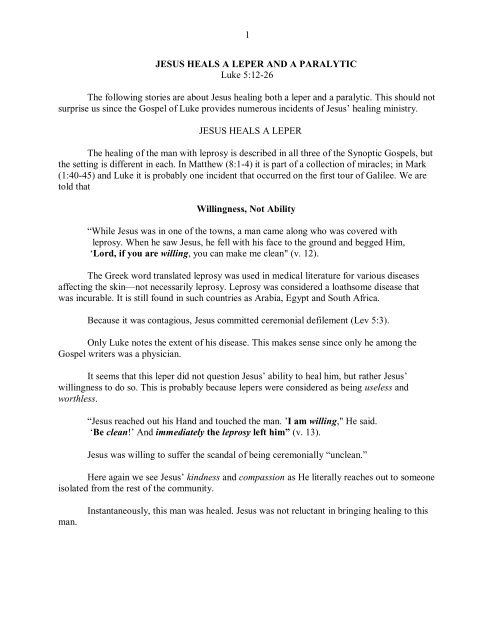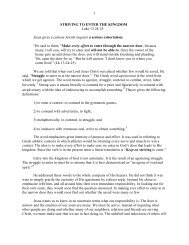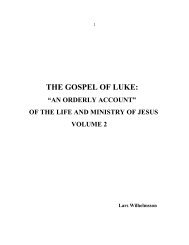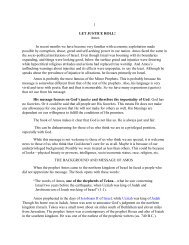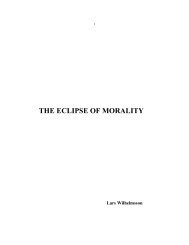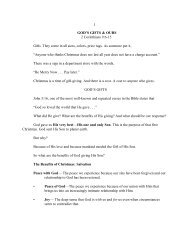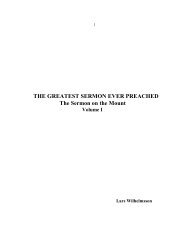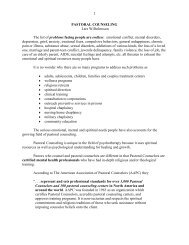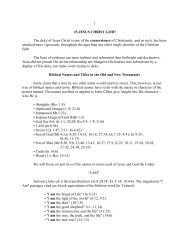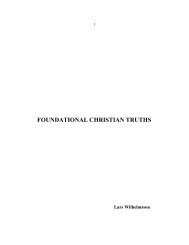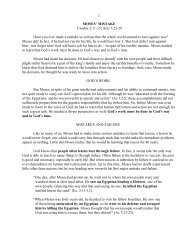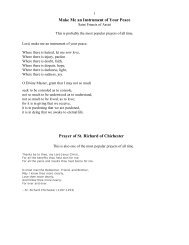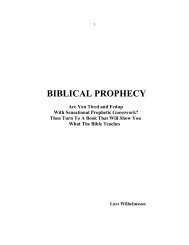Lk 5.12-26 Jesus Heals a Leper and a Paralytic - Vital Christianity
Lk 5.12-26 Jesus Heals a Leper and a Paralytic - Vital Christianity
Lk 5.12-26 Jesus Heals a Leper and a Paralytic - Vital Christianity
Create successful ePaper yourself
Turn your PDF publications into a flip-book with our unique Google optimized e-Paper software.
1<br />
JESUS HEALS A LEPER AND A PARALYTIC<br />
Luke 5:12-<strong>26</strong><br />
The following stories are about <strong>Jesus</strong> healing both a leper <strong>and</strong> a paralytic. This should not<br />
surprise us since the Gospel of Luke provides numerous incidents of <strong>Jesus</strong>’ healing ministry.<br />
JESUS HEALS A LEPER<br />
The healing of the man with leprosy is described in all three of the Synoptic Gospels, but<br />
the setting is different in each. In Matthew (8:1-4) it is part of a collection of miracles; in Mark<br />
(1:40-45) <strong>and</strong> Luke it is probably one incident that occurred on the first tour of Galilee. We are<br />
told that<br />
Willingness, Not Ability<br />
“While <strong>Jesus</strong> was in one of the towns, a man came along who was covered with<br />
leprosy. When he saw <strong>Jesus</strong>, he fell with his face to the ground <strong>and</strong> begged Him,<br />
‘Lord, if you are willing, you can make me clean" (v. 12).<br />
The Greek word translated leprosy was used in medical literature for various diseases<br />
affecting the skin—not necessarily leprosy. Leprosy was considered a loathsome disease that<br />
was incurable. It is still found in such countries as Arabia, Egypt <strong>and</strong> South Africa.<br />
Because it was contagious, <strong>Jesus</strong> committed ceremonial defilement (Lev 5:3).<br />
Only Luke notes the extent of his disease. This makes sense since only he among the<br />
Gospel writers was a physician.<br />
It seems that this leper did not question <strong>Jesus</strong>’ ability to heal him, but rather <strong>Jesus</strong>’<br />
willingness to do so. This is probably because lepers were considered as being useless <strong>and</strong><br />
worthless.<br />
“<strong>Jesus</strong> reached out his H<strong>and</strong> <strong>and</strong> touched the man. ’I am willing," He said.<br />
‘Be clean!’ And immediately the leprosy left him” (v. 13).<br />
<strong>Jesus</strong> was willing to suffer the sc<strong>and</strong>al of being ceremonially “unclean.”<br />
Here again we see <strong>Jesus</strong>’ kindness <strong>and</strong> compassion as He literally reaches out to someone<br />
isolated from the rest of the community.<br />
man.<br />
Instantaneously, this man was healed. <strong>Jesus</strong> was not reluctant in bringing healing to this
2<br />
A Strange Comm<strong>and</strong><br />
<strong>Jesus</strong> then ordered the man to follow an Old Testament practice. Luke tells us:<br />
“Then <strong>Jesus</strong> ordered him, "Don't tell anyone, but go, show yourself to the<br />
priest <strong>and</strong> offer the sacrifices that Moses comm<strong>and</strong>ed for your cleansing,<br />
as a testimony to them" (v. 14).<br />
<strong>Jesus</strong> orders this man to do something unnatural, that is, not to tell of the tremendous<br />
miracle he had just experienced. Full of gratitude, he is told not to express that gratitude.<br />
Typically we are told to express God’s goodness (Ps 66:16). But not in this case.<br />
Why?<br />
Because it was not the right time. It was not time yet for Him to be popular as a Healer.<br />
Otherwise it might interfere with His teaching ministry.<br />
The miraculous, the supernatural tends to trump everything else. People are easily<br />
attracted to the miraculous <strong>and</strong> it is easy for them to become so preoccupied with it, that they<br />
ignore what seems as more mundane <strong>and</strong> ordinary—teaching.<br />
By this comm<strong>and</strong> to show oneself to the priest, <strong>Jesus</strong> urged the man<br />
to keep the law, to provide further proof for the actual healing (Lev 13:43-44)<br />
to testify to the authorities concerning His ministry<br />
to supply ritual certification of cleansing so the man could be reinstated<br />
into society<br />
“Yet the news about Him spread all the more, so that crowds of people<br />
came to hear Him <strong>and</strong> to be healed of their sicknesses” (v. 15).<br />
In spite of ordering this man not to broadcast his healing, the news “spread all the more.”<br />
As a result sick people came to Him in droves <strong>and</strong> <strong>Jesus</strong> graciously “healed them of their<br />
sicknesses.”<br />
The Priority of Prayer<br />
“But <strong>Jesus</strong> often withdrew to lonely places <strong>and</strong> prayed” (v. 16).<br />
As Luke points out, <strong>Jesus</strong> “often” withdrew to pray (Mk 1:35; Jn 6:15). He was never too<br />
busy to pray. He kept His priorities straight. Is it any wonder <strong>Jesus</strong> said that His house will be a<br />
“House of Prayer” (Mk 11:17; Isa. 56:7; Mt 21:13).
3<br />
JESUS HEALS A PARALYTIC (5:17)<br />
“One day as He was teaching, Pharisees <strong>and</strong> teachers of the law, who had come<br />
from every village of Galilee <strong>and</strong> from Judea <strong>and</strong> Jerusalem, were sitting there.<br />
And the power of the Lord was present for him to heal the sick” (v. 17).<br />
Opposition was rising in Galilee from the Pharisees <strong>and</strong> teachers of the law. The<br />
Pharisees were literally “the separated ones” <strong>and</strong> they numbered around 6,000. They were<br />
<br />
<br />
<br />
Teachers in the synagogues<br />
Religious examples in the eyes of the people<br />
Guardians of the law <strong>and</strong> its proper observance.<br />
They considered the interpretations <strong>and</strong> regulations h<strong>and</strong>ed down by tradition to be<br />
virtually as authoritative as Scripture (Mk 7:8-13). The scribes or teachers of the law were those<br />
who studied, interpreted <strong>and</strong> taught the law (both written <strong>and</strong> oral). The majority of these<br />
teachers belonged to the part of the Pharisees.<br />
Notice the connection between “the power of the Lord” <strong>and</strong> healing.<br />
Desperate Friends<br />
“Some men came carrying a paralytic on a mat <strong>and</strong> tried to take him into the<br />
house to lay him before <strong>Jesus</strong>. When they could not find a way to do this<br />
because of the crowd, they went up on the roof <strong>and</strong> lowered him on his mat<br />
through the tiles into the middle of the crowd, right in front of <strong>Jesus</strong>” (vv. 18-19).<br />
The paralytic was fortunate to have such good friends, friends who in their desperation<br />
decided to do whatever necessary to have this paralytic get the help he needed.<br />
The Faith of Friends<br />
The following verse tells us that they were men of faith since <strong>Jesus</strong> “saw” their faith:<br />
“When <strong>Jesus</strong> saw their faith, he said, "Friend, your sins are forgiven" (v. 20).<br />
In response to the faith of the paralytic’s friends, <strong>Jesus</strong> assures them of their forgiveness.<br />
Blasphemy<br />
“The Pharisees <strong>and</strong> the teachers of the law began thinking to themselves,<br />
‘Who is this fellow who speaks blasphemy? Who can forgive sins but<br />
God alone?" (v. 21).
4<br />
The Pharisees considered blasphemy to be the most serious sin a person could commit:<br />
In Jewish theology even the Messiah could not forgive sins, <strong>and</strong> <strong>Jesus</strong>’ forgiveness of sin<br />
was a claim to deity—which they considered to be blasphemous.<br />
Blasphemy was punishable by death. And the method was death by stoning (Lev 24:16).<br />
“You have heard the blasphemy. What do you think? They all condemned Him<br />
as worthy of death” (Mk 14:64).<br />
Death is the judgment for blasphemy because it is an affront to the authority <strong>and</strong> majesty<br />
of God (Mk 2:7; 3:28-29; Jn 5:18; 10:33).<br />
<strong>Jesus</strong> Knew What They Were Thinking<br />
“<strong>Jesus</strong> knew what they were thinking <strong>and</strong> asked, "Why are you thinking these<br />
things in your hearts?” (v. 22).<br />
well:<br />
Here we see <strong>Jesus</strong> omniscience (all-knowingness). John points to this in his gospel as<br />
“Now while He was in Jerusalem at the Passover Feast, many people saw the<br />
miraculous signs He was doing <strong>and</strong> believed in His name. But <strong>Jesus</strong> would<br />
not entrust Himself to them, for He knew all men. He did not need man’s<br />
testimony about man, for He knew what was in a man” (Jn 2:23-25).<br />
Forgiveness or Healing<br />
Forgiveness or healing, which is easier? <strong>Jesus</strong> put it:<br />
“Which is easier: to say, 'Your sins are forgiven,' or to say, 'Get up <strong>and</strong> walk'?<br />
But that you may know that the Son of Man has authority on earth to<br />
forgive sins. . . ." (v. 23).<br />
<strong>Jesus</strong>’ point probably was that neither forgiving sins nor healing was easier. Both are<br />
equally impossible to people <strong>and</strong> equally easy to God.<br />
Instant Obedience<br />
“He said to the paralyzed man, ‘I tell you, get up, take your mat <strong>and</strong> go<br />
home.’ Immediately he stood up in front of them, took what he had been<br />
lying on <strong>and</strong> went home praising God” (vv. 24-25).<br />
<strong>Jesus</strong>’ power to heal was a visible affirmation of His power to forgive sins.
5<br />
Again we see instant obedience. No questions asked.<br />
Amazement <strong>and</strong> Praise<br />
Luke ends this section with peoples’ amazement <strong>and</strong> praise:<br />
“Everyone was amazed <strong>and</strong> gave praise to God. They were filled with awe <strong>and</strong><br />
said, "We have seen remarkable things today” (v. <strong>26</strong>).


